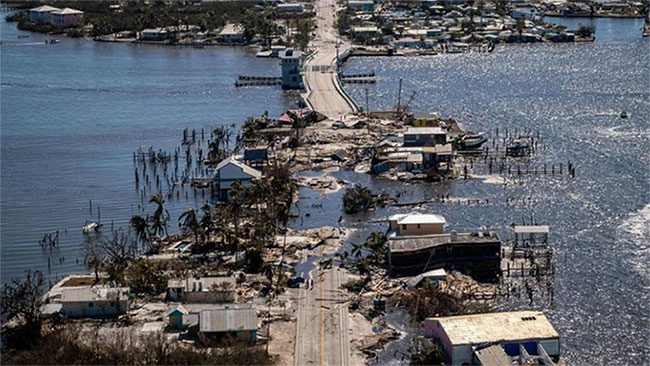According to new research, many countries are choosing to build new cities in areas that are at high risk of flooding. Vietnam is also among those that need to be warned.
The study published in the journal Nature earlier in October reported that from 1985 to 2015, the number of settlements—from small villages to large cities—located in high flood risk areas increased by 122%.
East Asia – Pacific Region at Highest Risk
Mr. Paolo Avner, a senior economist at the World Bank and the lead author of the study, stated: “At a time when humanity needs to adapt to climate change, many countries are rapidly increasing new settlements in flood-prone areas.”
“This is a concerning trend, especially as climate change is exacerbating flood disasters worldwide,” he told CNN.

Matlacha neighborhood destroyed after Hurricane Ian in Fort Myers, Florida, on September 30, 2022 – (Photo: AFP).
The researchers analyzed a dataset on global flood risk while also examining annual settlement trends over three decades from 1985 to 2015 to identify the populations most affected by flood risks.
They found that during this period, as the number of settlements worldwide increased by 85%, urbanization occurred much faster in high flood-risk areas.
According to the report, over 11% of global built-up areas are facing high or very high flood risk (with a risk of flooding of at least 50 cm).
The level of settlements affected by flooding is highest in East Asia and the Pacific region, while it is lowest in North America and sub-Saharan Africa.
Countries with high-income levels have the largest proportion of new settlers located in the highest flood-risk areas. China is a prime example, having undergone rapid urbanization and being home to nearly half of the new settlements built in high flood risk areas from 1985 to 2015.
Many New Coastal Development Projects in Vietnam “Fall into Dangerous Areas”
There are several reasons for the increase in construction in flood-prone lands, but land scarcity is the primary cause.
As safer land areas have become full, people are forced to look elsewhere, even in areas they previously avoided.
The report indicates that Vietnam has about one-third of its coastal land developed, and new development projects are now falling into hazardous zones.
The second reason is financial. Sometimes, economic opportunities are prioritized over the perceived distant disaster risks, particularly for large port cities, coastal communities, or tourist areas.
Other reasons include a lack of flood data, poor urban planning, or weak regulations.
The report recommends that policymakers and planners invest in disaster prevention, early warning systems, and evacuation plans in high flood risk areas; as well as review land use plans and building codes in flood-prone regions.




















































